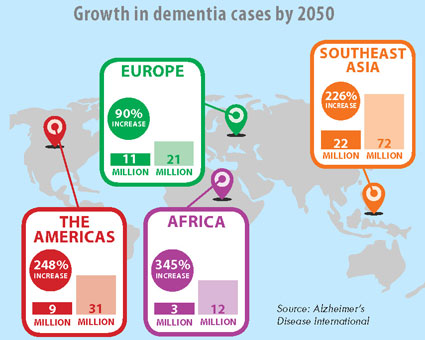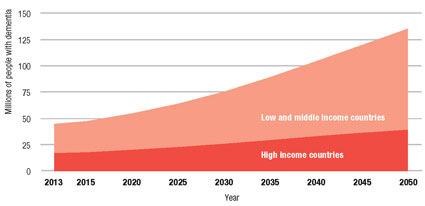NIH meeting advances Alzheimer's research agenda
March / April 2015 | Volume 14, Issue 2

Source:
Dementia: A global epidemic infographic
from Alzheimer's Disease International
Infographic description: World map showing growth in dementia cases by world
region by 2050.
The Americas: 248% increase, 9 million to 31 million
Europe: 90% increase, 11 million to 21 million
Africa: 345% increase, 3 million to 12 million
Southeast Asia: 226% increase, 22 million to 72 million
Scientists studying dementia are making "fantastic" advances, NIH Director Dr. Francis S. Collins told attendees of the
Alzheimer's Disease (AD) Research Summit held recently on the Bethesda campus. The number of people with dementia is expected to skyrocket globally over the next 35 years - especially in developing countries - but Collins expressed hope that effective interventions will be discovered soon.
Several hundred participants from academia, industry, federal agencies, foundations and advocacy groups came together for the conference, organized by NIH's National Institute on Aging (NIA), to share progress and build on previous efforts to develop an integrated, multidisciplinary research agenda. Although many challenges remain, there is cause for optimism, Collins said. "I think we've entered a new era in Alzheimer's research."
Advances in genomics, large-scale studies of individuals, and new models of collaboration and data sharing, are driving progress, he said. A portal to pool complex biomedical data and analyses regarding
Alzheimer's Disease has been launched by the Accelerating Medicines Partnership, an NIH-led venture designed to hasten advances.
"The enormous complexity of the human brain and the processes involved in development and progression of Alzheimer's disease have been major barriers to drug development," said NIA Director Dr. Richard J. Hodes. "Now that we are gathering the data and developing the tools needed to tackle this complexity, it is key to make them widely accessible to the research community so we can speed up the development of critically needed therapies."
In addition, NIA has developed a public database of research projects underway and their funding sources, known as the
International Alzheimer's Disease Research Portfolio (IADRP), launched as a joint collaboration between NIA and the Alzheimer's Association, so scientists can coordinate efforts and spot neglected areas for study. Finally, the new Precision Medicine Initiative may also aid dementia research, as it is intended to pioneer an innovative approach to disease prevention and treatment, taking into account individual differences in people's genes, environments and lifestyles.
Global burden expected to triple
For the first time in human history, the number of people older than 65 will soon be greater than those under age five, predicted Dr. Kenneth Langa of the University of Michigan. By 2050, there will be about 1.5 billion people over 65, he said. Total dementia cases are expected to climb from 44 million now, to 135 million by 2050, according to the latest report from Alzheimer's Disease International. The annual financial burden associated with dementia is already staggering - $200 billion in the U.S. and $604 billion globally.
Number of people with dementia in
LMICs compared to HIC

Source:
The Global Impact of Dementia 2013-2050
from Alzheimer's Disease International
Graph description: Line graph showing increase in millions of people with
dementia in low- and middle-income countries compared to high-income
countries from 2013 to 2050. LMICs from about 45 million to about 130
million. HIC from about 20 million to about 35 million.
"Dementia has a large and growing health, social and economic impact around the world, with a current magnitude as great as common diseases such as heart disease and cancer," Langa observed.
Although the current dementia incidence rates are pretty similar around the world - about 5 to 7 percent - the prevalence estimates for 2050 indicate that will change dramatically, according to Dr. Martin Prince of King's College London. The number of dementia patients is expected to double in the North, triple in Southeast Asia, and quadruple in Africa and Latin America. "It's crucial that we have a global perspective on this," he noted.
Prevention possibilities
However, there have been some positive developments, Langa reported. Age-specific risk of dementia has dropped in high-income countries over last 25 years. There is some evidence that the expansion of educational opportunities is driving that decline, he said. Literacy rates are rising around the world, including among women and girls, which has important implications for reducing risk for AD.
"The benefits of education, make it potentially an especially important strategy for dementia prevention," suggested Langa. New online instruction resources could help build cognitive reserve, especially in low- and middle-income country populations.
Prevention is beginning to rise on the research agenda, Prince said. A review he conducted of existing studies found robust evidence for four associations - education in early life, hypertension in midlife, and diabetes and smoking across the lifespan. There was less conclusive proof for other factors including depression, obesity, alcohol, hyperlipidemia, physical activity and cognitive stimulation, he said.
Considering how to frame the discussion will be key, Prince suggested. "It's not widely accepted or understood that dementia is a preventable condition. And it needs to be," he said. "There are two messages here, it's never too early to make changes that will reduce your risk of developing dementia in late life and developing a better brain. But it's also never too late, arguably, with diabetes and smoking, for example, to make changes that might influence your course in later life."
It is critical that countries monitor the epidemic in terms of changes in prevalence, changes in incidence, changes in dementia-related mortality, and relate those to changes to exposures to risk factors within their populations, urged Prince.
Although the disease burden is growing rapidly, research funding is also rising, up 42 percent since 2011, Collins observed. "Scientific opportunities have never been better and the public health need so compelling."
More Information
NIH and HHS resources related to Alzheimer's disease:
Alzheimer's disease news and research resources from other organizations:
To view Adobe PDF files,
download current, free accessible plug-ins from Adobe's website.